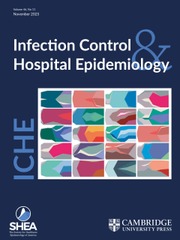No CrossRef data available.
Article contents
Colonization with antiseptic tolerant Staphylococcus aureus in children with cancer: a longitudinal study
Published online by Cambridge University Press: 11 September 2025
Abstract
In Staphylococcus aureus the qacA/B and smr genes have been associated with elevated MICs to antiseptics with such organisms often termed antiseptic tolerant S. aureus (ATSA). The impact of repeated healthcare or antiseptic exposure on colonization with ATSA is uncertain.
Prospective longitudinal cohort study.
The high-risk cohort included children with a new diagnosis of malignancy recruited from a pediatric oncology clinic. The low-risk cohort were otherwise healthy children enrolled from general pediatrics clinics.
Subjects had anterior nares and axillary cultures collected at 3-month intervals for one year. Identified S. aureus isolates underwent PCR for qacA/B and smr. The primary outcome was colonization with ATSA at least once during study follow-up. Logistic regression models were utilized to adjust for confounding across cohorts.
226 subjects were evaluable for the primary outcome. It was noted that 93.5% of high-risk subjects reported regularly using chlorhexidine gluconate (CHG) antiseptic products. Colonization with ATSA was found in 15.5% of subjects. In univariable analyses, subjects in the low-risk cohort more frequently had ATSA colonization; following adjustment for confounders, the rates of overall ATSA colonization were similar in the high- and low-risk cohorts. Only 2 subjects had colonization with an ATSA strain at more than one encounter.
Pediatric oncology patients do not experience higher rates of ATSA colonization than healthy children. In addition, ATSA colonization is transient relative to strains negative for smr/qacA/B. These findings suggest that repeated use of infection prevention strategies including CHG do not predispose to colonization with ATSA in the ambulatory setting.
Information
- Type
- Original Article
- Information
- Copyright
- © The Author(s), 2025. Published by Cambridge University Press on behalf of The Society for Healthcare Epidemiology of America
Footnotes
Preliminary results from this study were presented at the 2023 American Society for Microbiology ASM Microbe meeting, abstract #3917.


